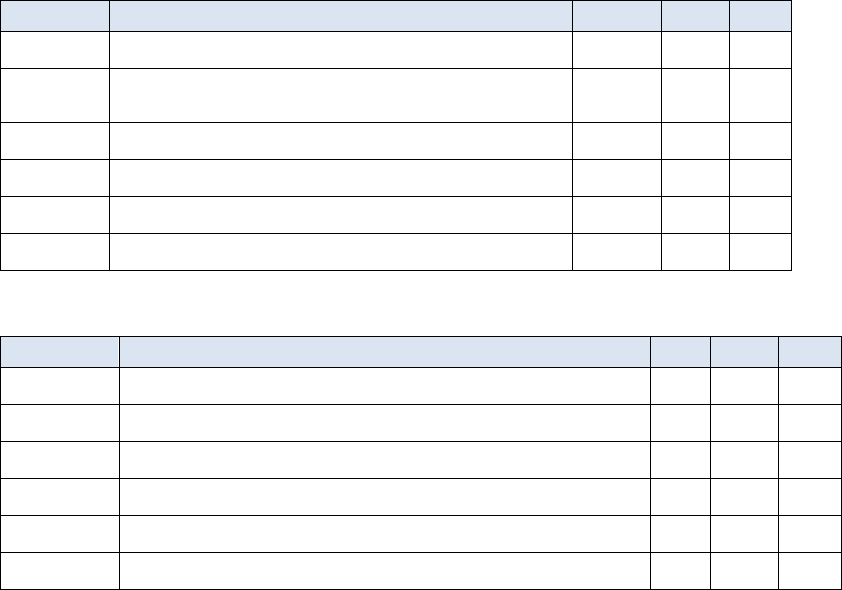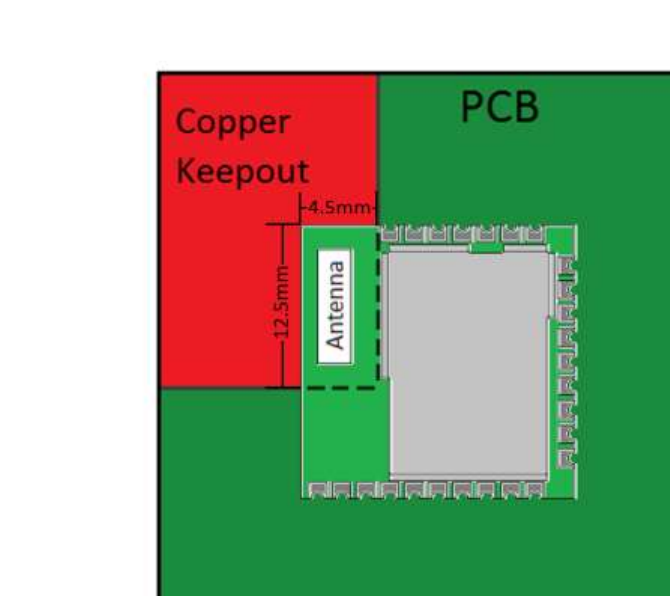Manual

BMD-200 V0.1 PRELIMINARY Page
Page 1 of 9
Rigado LLC
2601 25
th
ST SE Suite 200
Salem, Oregon 97302
866-6-RIGADO
(f) 971-208-9869
Blumod BMD-200 Module for Bluetooth 4.0 LE
The blumod BMD-200 from Rigado is a powerful, highly flexible Bluetooth Smart module based on the
nRF51822 SoC from Nordic Semiconductor. With a ARM® Cortex™ M0 CPU, embedded 2.4GHz transceiver,
and on-module chip antenna, the BMD-200 provides a complete RF solution with no additional RF design,
allowing faster time to market. The BMD-200 provides full use of the nRF51822’s on-chip peripherals,
allowing for a wide range of applications without the need for an external host microcontroller; simplifying
designs and reducing BOM costs. With an internal DC-DC converter and a voltage supply range of 2.1V to 3.6V,
the BMD-200 can be powered directly from a coin cell or two AAA batteries with ultra-low power
consumption.
Features
Based on the Nordic nRF51822 SoC
Complete RF solution with integrated chip
antenna
Integrated DC-DC converter
No external components required
ARM® Cortex™-M0 32 bit processor
Serial Wire Debug (SWD)
S100 series SoftDevice ready
256 kB embedded flash program memory
16 kB RAM
8/9/10 bit ADC - 8 configurable channels
15 General Purpose I/O Pins
One 32 bit and two 16 bit timers with counter
mode
SPI Master/Slave (4 Mbps)
Low power comparator
Temperature sensor
Two-wire Master (I2C compatible)
UART (w/ CTS/RTS)
CPU independent Programmable Peripheral
Interconnect (PPI)
Quadrature Decoder (QDEC)
AES HW encryption
Real Timer Counter (RTC)
Applications
Appcessories
iBeacons™
Low-Power Sensors
Connected Appliances
Lighting Products
Health/Fitness devices
Wearables

BMD-200 V0.1 PRELIMINARY Page 2 of 9
Quick Specifications
Bluetooth
Version
4.0 (Bluetooth Smart)
Security
AES-128
LE connections
up to 8
Radio
Frequency
2.402GHz to 2480GHz
Modulations
GFSK at 250 kbps, 1 Mbps, 2 Mbps data rates
Transmit power
+4 dBm
Receiver sensitivity
-93 dBm
Typical line-of-sight range
30 - 150 meters
Antenna
Integrated ceramic chip
Current Consumption
TX only @ +4 dBm, 0 dBm, -4 dBm
16 mA, 10.5 mA, 8 mA
RX only @ 2 Mbps, 1 Mbps, 250 kbps
13.4 mA, 13 mA, 12.6 mA
CPU @ 16MHz from flash, from RAM
4.4 mA, 2.4 mA
System Off , w/ 16K RAM, 8K RAM, no RAM retention
1.8 uA, 1.2 uA, 0.6 uA
Dimensions
Length
17.00 mm
Width
17.00 mm
Height
2.89 mm
Hardware
Interface
SPI Master/Slave, UART, Two-Wire Master, GPIO
Power supply
2.1V to 3.6V
Certifications
FCC
FCC part 15 modular qualification

BMD-200 V0.1 PRELIMINARY Page 3 of 9
Absolution Maximum Ratings
Symbol
Parameter
Min.
Max.
Unit
VCC_MAX
Voltage on supply pin
-0.3
3.9
V
VIO_MAX
Voltage on GPIO pins
-0.3
VCC + 0.3
V
TS
Storage Temperature Range
-40
125
°C
Operating Conditions
Symbol
Parameter
Min.
Typ.
Max.
Unit
VCC
Operating supply voltage
2.1
3.0
3.6
V
TR_VCC
Supply rise time (0V to 1.8V)
-
-
60
ms
TA
Operating Ambient Temperature Range
-25
25
75
°C
GPIO Specifications
Symbol
Parameter
Min.
Typ.
Max.
Unit
VIH
Input High Voltage
0.7 x VCC
-
VCC
V
VIL
Input Low Voltage
VSS
-
0.3 x VCC
V
VOH
Output High Voltage
VCC – 0.3
-
VCC
V
VOL
Output Low Voltage
VSS
-
0.3
V
RPU
Pull-up Resistance
11
13
16
kΩ
RPD
Pull-down Resistance
11
13
16
kΩ
Note: GPIO have a standard drive strength of 0.5 mA, and a high drive strength of 5 mA. Maximum number of
high drive strength pins is 3.
Clocks
The BMD-200 module requires two clocks, a high frequency clock and a low frequency clock.
The high frequency clock is provided internally by a high-accuracy 16-MHz crystal as required by the nRF51822
for radio operation.
The low frequency clock can be provided internally by an RC oscillator or synthesized from the fast clock; or
externally by a 32.768 kHz crystal. An external crystal provides the lowest power consumption.

BMD-200 V0.1 CONFIDENTIAL Page 4 of 9
32.768 kHz Crystal Specification Requirements
Symbol
Parameter
Typ.
Max.
Unit
fnom
Crystal frequency
32.768
-
kHz
Ftol,BLE
Frequency tolerance, Bluetooth low energy
applications.
±250
-
ppm
Cl
Load Capacitance
-
12.5
pF
Co
Shunt Capacitance
-
2
pF
Rs
Equivalent series resistance
50
80
kΩ
Cpin
Input Capacitance on XTAL1 & XTAL2
5
-
pF
32.768 kHz Oscillator Comparison
Symbol
Parameter
Typ.
Max.
Unit
IX32k
Current for 32.768kHz Crystal Oscillator
0.4
1
uA
IRC32k
Current for 32.768kHz RC Oscillator
0.8
1.1
uA
ISYNT32k
Current for 32.768kHz Synthesized Oscillator
15
-
uA
FTOL,X32k
Frequency Tolerance, 32.768kHz Crystal Oscillator
-
±250
ppm
F TOL,RC32k
Frequency Tolerance, 32.768kHz RC Oscillator
±2
-
%
F TOL,SYNT32k
Frequency Tolerance, 32.768kHz Synthesized Oscillator
±34
-
ppm
Note: FTOL,X32k is max tolerance allowed for BLE applications. Actual tolerance depends on the
crystal used.

BMD-200 V0.1 CONFIDENTIAL Page 5 of 9
Pinout
Top View
Pin description (PRELIMINARY)
Name
Pin
Direction
Description
P0.24
5
In/Out
GPIO
P0.25
6
In/Out
GPIO
P0.26
8
In/Out
GPIO/AIN1/XTAL2 (32.768kHz)
P0.27
9
In/Out
GPIO/AIN0/XTAL1(32.768kHz)
P0.00
11
In/Out
GPIO/AREF0
P0.01
12
In/Out
GPIO/AIN2
P0.02
13
In/Out
GPIO/AIN3
P0.03
14
In/Out
GPIO/AIN4
P0.04
15
In/Out
GPIO/AIN5
P0.05
16
In/Out
GPIO/AIN6
P0.06
17
In/Out
GPIO/AIN7/AREF1
P0.08
20
In/Out
GPIO
P0.09
21
In/Out
GPIO
P0.10
22
In/Out
GPIO
P0.11
23
In/Out
GPIO
SWDIO
24
In/Out
SWD IO/
SWDCLK
25
In
SWD Clock 1
VCC
18
Pwr
+2.1 to +3.6VDC input 2
GND
1, 2, 3, 4, 7, 10, 19,
26, (27, 28 opt.)
Pwr
Electrical Ground
Note 1: SWDCLK has a 12 kΩ pull-down resistor.
Note 2: An external capacitor for VCC is not strictly required, however using a 1µF - 4.7µF
ceramic capacitor is recommended.

BMD-200 V0.1 CONFIDENTIAL Page 6 of 9
Mechanical Dimensions
Recommended PCB Land Pad (Top view)
(All dimensions are in mm)

BMD-200 V0.1 CONFIDENTIAL Page 7 of 9
Recommended Copper Keepout
The area under and extending out from the antenna portion of the module should be kept clear of copper and
other metal. The module should be placed at the edge or, ideally, at the corner of the PCB with the antenna
edge facing out.
BMD-200 V0.1 CONFIDENTIAL Page 8 of 9
FCC Certification
The BMD-200 module has a certification from the FCC to be used as a modular transmitter. Devices that
include the BMD-200 must state on the label that it “Contains FCC ID: 2AA9B01”.
FCC Statement
This device has been tested and found to comply with part 15 of the FCC rules. These limits are designed to
provide reasonable protection against harmful interference in a residential installation. This equipment
generates, uses and can radiate radio frequency energy and, if not installed and used in accordance with the
instructions, may cause harmful interference to radio communications. However, there is no guarantee that
interference will not occur in a particular installation. If this equipment does cause harmful interference to
radio or television reception, which can be determined by turning the equipment off and on, the user is
encouraged to try to correct the interference by one or more of the following measures:
Reorient or relocate the receiving antenna.
Increase the separation between the equipment and the receiver
Connect the equipment into an outlet on a circuit different from that to which the receiver is
connected.
Consult the dealer or an experienced radio/TV technician for help.
Operation is subjected to the following two conditions: (1) This device may no cause harmful interference, and
(2) this device must accept any interference received, including interference that may cause undesired
operation. Note: Modification to this product will void the user’s authority to operate this equipment.
Note: Modification to this product will void the users’ authority to operate this equipment.
FCC Important Notes:
(1) FCC Radiation Exposure Statement
This equipment complies with FCC RF radiation exposure limits set forth for an uncontrolled
environment. This transmitter should be installed and operated with a minimum distance of 20
Centimeter between the radiator and your body and must not be co-located or operating in
conjunction with any other antenna or transmitter.
This equipment complies with Part 15 of the FCC Rules. Operation is subject the following two
conditions:
(1) This device may not cause harmful interference, and
(2) This device must accept any interference received, including interference that may cause
undesired operation.
BMD-200 V0.1 CONFIDENTIAL Page 9 of 9
The devices must be installed and used in strict accordance with the manufacturer’s instructions as
described in the user documentation that comes with the product. Modular could be only used in
mobile or fix device, and could not be used in any portable device.
Caution!
The manufacturer is not responsible for any radio or TV interference caused by unauthorized
modifications to this equipment. Such modification could void the user authority to operate the
equipment.
(2) Co-location Warning:
This device and its antenna(s) must not be co-located or operating in conjunction with any other
antenna or transmitter.
(3) OEM integration instructions:
This device is intended only for OEM integrators under the following conditions:
The antenna must be installed such that 20 cm is maintained between the antenna and users, and
the transmitter module may not be co-located with any other transmit or antenna. The module shall
be only used with the integral antenna(s) that has been originally tested and certified with this
module.
As long as 3 conditions above are met, further transmitter test will not be required. However, the
OEM integrator is still responsible for testing their end-product for any additional compliance
requirement with this module installed(for example, digital device emission, PC peripheral
requirements, etc.)
(4) OEM integration instructions:
In the event that these conditions cannot be met (for example certain laptop configuration or co-
location with another transmitter), then the FCC authorization for this module in combination with
the host equipment is no longer considered valid and the FCC ID of the module cannot be used on
the final product. In these and circumstance, the OEM integrator will be responsible for re-
evaluating. The end product (including the transmitter) and obtaining a separate FCC authorization.
(5) End product labeling:
This transmitter module is authorization only for use in device where the antenna may be installed
such that 20 cm may be maintained between the antenna and users. The final end product must be
labeled in a visible area with the following:
“Contains Transmitter Module FCC ID: 2AA9B01
(6) Information that must be placed in the end user manual:
The OEM integrator has to be aware not to provide information to the end user regarding how to
install or remove this RF module in the user’s manual of the end product which integrates this
module. The end user manual shall include all required regulatory information/warning as show in
this manual.